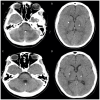Neurological and systemic effects of cocaine toxicity: A case report and review of the literature
- PMID: 39421719
- PMCID: PMC11484531
- DOI: 10.3892/mi.2024.196
Neurological and systemic effects of cocaine toxicity: A case report and review of the literature
Abstract
While historically utilized as a topical anesthetic and active ingredient in a variety of tonics, beverages and cure-alls, cocaine is a commonly abused illicit substance. Cocaine use is associated with a variety of neurological and systemic complications. The present study describes the case of a 23-year-old female patient presenting with profound neurological and systemic complications of cocaine, including coma, leukoencephaloapthy, neurogenic stunned myocardium, transaminitis, acute kidney injury, rhabdomyolysis and mononeuropathy. The supportive management and subsequent outcomes of the patients are discussed in detail. The approach to coma is also discussed, including stabilization and supportive care, diagnostic considerations and management. Key considerations relating prognosticating disorders of consciousness are also highlighted.
Keywords: cocaine; coma; leukoencephalopathy; overdose; toxicity.
Copyright: © 2024 Hong and Kromm.
Conflict of interest statement
The authors declare that they have no competing interests.
Figures



References
-
- Annual Reports Questionnaire: Annual prevalence of drug use: Amphetamines (Internet). https://public.tableau.com/views/Prevalence-general/Prevalence-general-h.... Accessed August 23, 2024.
Publication types
LinkOut - more resources
Full Text Sources
